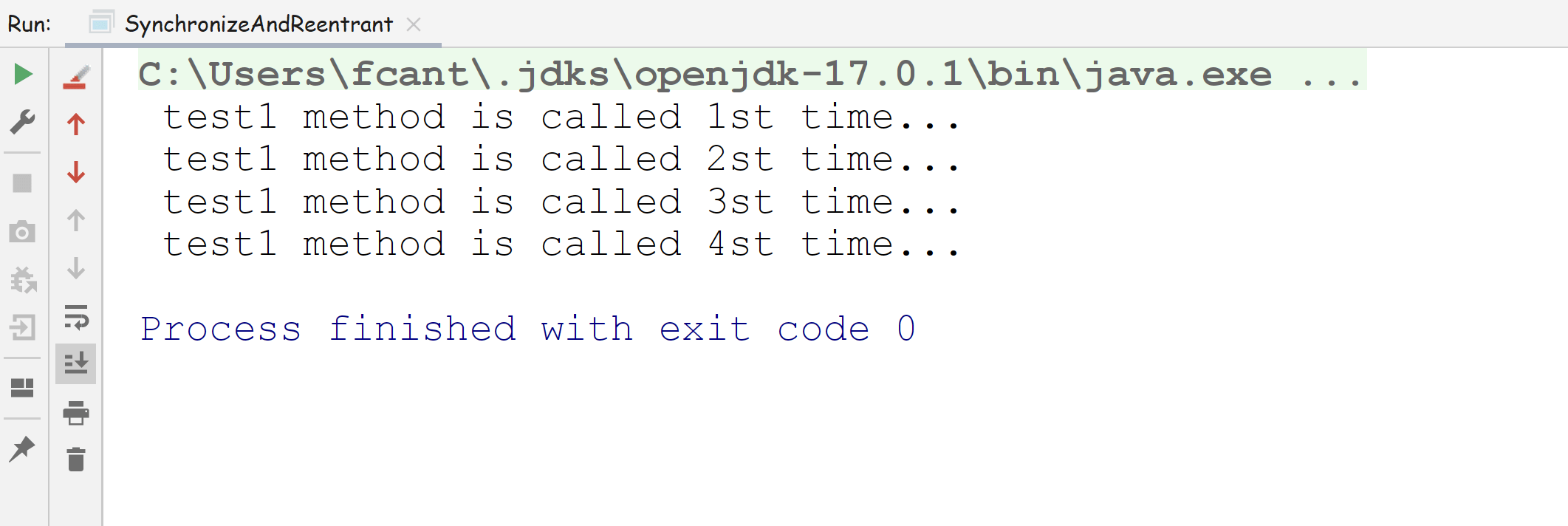1、前言
synchronized锁是jvm内置的锁,不同于ReentrantLock锁。synchronized关键字可以修饰方法,也可以修饰代码块。synchronized关键字修饰方法时可以修饰静态方法,也可以修饰非静态方法;同样,synchronized关键字修饰代码块时可以修饰对象,也可以修饰类。当然,synchronized修饰静态方法/类和非静态方法/对象时的作用范围是不同的。下面通过各种demo来详解synchronized的各种用法及注意事项。
2、synchronized类锁
这里所说的synchronized类锁的作用范围是类级别的,不会因为同一个类的不同对象执行而失效。
2.1 synchronized修饰同一个类的两个静态方法时互斥
public class SynchronizeAndClassLock {public static void main(String[] args) throws Exception {new Thread(() -> {// new了一个ClassLock对象new ClassLock().test1();}).start();new Thread(() -> {// new了另一个ClassLock对象new ClassLock().test2();}).start();}}class ClassLock {public synchronized static void test1(){System.out.println(new Date() + " " + Thread.currentThread().getName() + " begin...");try {TimeUnit.SECONDS.sleep(1);} catch (Exception e) {}System.out.println(new Date() + " " + Thread.currentThread().getName() + " end...");}// 【注意】public static void test2(){ 不会互斥,因为此时test2没有使用类锁。public synchronized static void test2(){System.out.println(new Date() + " " + Thread.currentThread().getName() + " begin...");try {TimeUnit.SECONDS.sleep(1);} catch (Exception e) {}System.out.println(new Date() + " " + Thread.currentThread().getName() + " end...");}}
运行结果:
【结论】两个线程分别同时执行同一个类产生的不同对象的两个不同 synchronized static方法,类锁生效,虽然是不同对象,因为两个线程使用的是同一个类锁。反过来,假如test2方法没有synchronized修饰的话,只有test1方法有被synchronized修饰,此时两个方法也不会互斥,一个有锁,一个没有锁,自然不会互斥。
2.2 synchronized分别修饰同一个类的静态方法和当前类时互斥
public class SynchronizeAndClassLock2 {public static void main(String[] args) throws Exception {new Thread(() -> {// new了一个ClassLock2对象new ClassLock2().test1();// ClassLock2.test1();}).start();new Thread(() -> {// new了另一个ClassLock2对象new ClassLock2().test2();// ClassLock2.test2();}).start();}}class ClassLock2 {public synchronized static void test1(){System.out.println(new Date() + " " + Thread.currentThread().getName() + " begin...");try {TimeUnit.SECONDS.sleep(1);} catch (Exception e) {}System.out.println(new Date() + " " + Thread.currentThread().getName() + " end...");}public static void test2(){// 【注意】synchronized (SynchronizeAndClassLock2.class)不会互斥synchronized (ClassLock2.class) {System.out.println(new Date() + " " + Thread.currentThread().getName() + " begin...");try {TimeUnit.SECONDS.sleep(1);} catch (Exception e) {}System.out.println(new Date() + " " + Thread.currentThread().getName() + " end...");}}}
运行结果:
【结论】两个线程同时分别执行一个被synchronized修饰static方法,一个有synchnized(该类)代码块的static方法,锁生效,虽然是不同对象,因为两个线程使用的同一个类锁。反过来,如果是修饰的不同类,因为类锁不同,肯定不会互斥,比如将test2方法的synchronized (ClassLock2.class)这句代码改成synchronized (SynchronizeAndClassLock2.class),此时不会互斥。
2.3 synchronized分别修饰同一个静态对象时互斥
public class SynchronizeAndClassLock10 {public static void main(String[] args) throws Exception {new Thread(() -> {new RunObject1().test1();}).start();new Thread(() -> {new RunObject2().test2();}).start();}}class RunObject1 {public static void test1(){// 【1】synchronized (StaticLock2.staticLock1) {synchronized (StaticLock2.staticLock) {System.out.println(new Date() + " " + Thread.currentThread().getName() + " begin...");try {TimeUnit.SECONDS.sleep(1);} catch (Exception e) {}System.out.println(new Date() + " " + Thread.currentThread().getName() + " end...");}}}class RunObject2 {public static void test2() {// 【2】synchronized (StaticLock2.staticLock2) {synchronized (StaticLock2.staticLock) {System.out.println(new Date() + " " + Thread.currentThread().getName() + " begin...");try {TimeUnit.SECONDS.sleep(1);} catch (Exception e) {}System.out.println(new Date() + " " + Thread.currentThread().getName() + " end...");}}}class StaticLock2 {public static Object staticLock = new Object();}
运行结果:
【结论】synchronized分别修饰同一个类的静态对象时互斥,反过来,如果是修饰不同的静态对象,肯定不会互斥,比如将上面代码中标【1】和【2】的synchronized代码结合使用。
3、synchronized对象锁
这里说的synchronized对象锁的作用范围是对象级别的即仅仅作用于同一个对象,如果是同一个类的两个不同的对象是不会互斥的,即没有效果的。
3.1 synchronized修饰同一个类对象的两个非静态方法时互斥
public class SynchronizeAndObjectLock2 {public static void main(String[] args) throws Exception {// 【注意】当且仅当是同一个SynchronizeAndObjectLock2对象SynchronizeAndObjectLock2 synchronizeAndObjectLock2 = new SynchronizeAndObjectLock2();new Thread(() -> {synchronizeAndObjectLock2.test1();}).start();new Thread(() -> {synchronizeAndObjectLock2.test2();}).start();}public synchronized void test1(){System.out.println(new Date() + " " + Thread.currentThread().getName() + " begin...");try {TimeUnit.SECONDS.sleep(1);} catch (Exception e) {}System.out.println(new Date() + " " + Thread.currentThread().getName() + " end...");}public synchronized void test2(){System.out.println(new Date() + " " + Thread.currentThread().getName() + " begin...");try {TimeUnit.SECONDS.sleep(1);} catch (Exception e) {}System.out.println(new Date() + " " + Thread.currentThread().getName() + " end...");}}
运行结果:
【结论】两个线程同时执行被synchronized修饰的相同对象的不同(相同)方法,锁生效,因为两个线程使用的是相同的对象锁
3.2 synchronized分别修饰同一个类对象的非静态方法和当前对象时互斥
public class SynchronizeAndObjectLock3 {public static void main(String[] args) throws Exception {// 【注意】当且仅当是同一个SynchronizeAndObjectLock3对象SynchronizeAndObjectLock3 synchronizeAndObjectLock3 = new SynchronizeAndObjectLock3();new Thread(() -> {synchronizeAndObjectLock3.test1();}).start();new Thread(() -> {synchronizeAndObjectLock3.test2();}).start();}public void test1(){synchronized(this) {System.out.println(new Date() + " " + Thread.currentThread().getName() + " begin...");try {TimeUnit.SECONDS.sleep(1);} catch (Exception e) {}System.out.println(new Date() + " " + Thread.currentThread().getName() + " end...");}}public synchronized void test2(){System.out.println(new Date() + " " + Thread.currentThread().getName() + " begin...");try {TimeUnit.SECONDS.sleep(1);} catch (Exception e) {}System.out.println(new Date() + " " + Thread.currentThread().getName() + " end...");}}
运行结果:
【结论】snchronized修饰非静态方法与synchronized(this)互斥,可见,snchronized修饰非静态方法实质锁的是当前对象。
3.3 synchronized修饰不同对象的两个非静态方法时不会互斥
public class SynchronizeAndObjectLock {public static void main(String[] args) throws Exception {new Thread(() -> {// 这里new 了一个SynchronizeAndObjectLock对象new SynchronizeAndObjectLock().test1();}).start();new Thread(() -> {// 这里new 了另一个SynchronizeAndObjectLock对象new SynchronizeAndObjectLock().test2();}).start();}public synchronized void test1(){System.out.println(new Date() + " " + Thread.currentThread().getName() + " begin...");try {TimeUnit.SECONDS.sleep(1);} catch (Exception e) {}System.out.println(new Date() + " " + Thread.currentThread().getName() + " end...");}public synchronized void test2(){System.out.println(new Date() + " " + Thread.currentThread().getName() + " begin...");try {TimeUnit.SECONDS.sleep(1);} catch (Exception e) {}System.out.println(new Date() + " " + Thread.currentThread().getName() + " end...");}}
运行结果:
【结论】两个线程同时执行被synchronized修饰的不同对象的不同(相同)方法,锁未生效,因为两个线程使用的是不同的对象锁。
3.4 synchronized代码块修饰同一个对象时互斥
public class SynchronizeAndObjectLock5 {private Object objectLock = new Object();public static void main(String[] args) throws Exception {SynchronizeAndObjectLock5 synchronizeAndObjectLock5 = new SynchronizeAndObjectLock5();new Thread(() -> {synchronizeAndObjectLock5.test1();}).start();new Thread(() -> {synchronizeAndObjectLock5.test2();}).start();}public void test1(){synchronized(objectLock) {System.out.println(new Date() + " " + Thread.currentThread().getName() + " begin...");try {TimeUnit.SECONDS.sleep(1);} catch (Exception e) {}System.out.println(new Date() + " " + Thread.currentThread().getName() + " end...");}}public void test2(){synchronized(objectLock) {System.out.println(new Date() + " " + Thread.currentThread().getName() + " begin...");try {TimeUnit.SECONDS.sleep(1);} catch (Exception e) {}System.out.println(new Date() + " " + Thread.currentThread().getName() + " end...");}}}
运行结果:
【结论】synchronized代码块修饰同一个对象时互斥,若synchronized代码块修饰的是不同对象,那么不会互斥。
4、synchronized修饰当前类和当前对象时不会互斥
public class ClassAndObjectLock {public static void main(String[] args) throws Exception {new Thread(() -> {ClassAndObjectLock.test1();}).start();new Thread(() -> {new ClassAndObjectLock().test2();}).start();}public static void test1(){synchronized (ClassAndObjectLock.class) {System.out.println(new Date() + " " + Thread.currentThread().getName() + " begin...");try {TimeUnit.SECONDS.sleep(1);} catch (Exception e) {}System.out.println(new Date() + " " + Thread.currentThread().getName() + " end...");}}public void test2(){synchronized (this) {System.out.println(new Date() + " " + Thread.currentThread().getName() + " begin...");try {TimeUnit.SECONDS.sleep(1);} catch (Exception e) {}System.out.println(new Date() + " " + Thread.currentThread().getName() + " end...");}}}
运行结果:
【结论】可见,类锁和对象锁是相互独立的,互不相斥。
5、synchronized锁注意事项
5.1 synchronized锁不能被中断
为了模拟synchronized锁不可中断,下面先让两个线程进入死锁,然后再用main线程去中断其中一个线程,看被中断的线程能否释放锁并被唤醒。
public class DeadLockCannotInterruptDemo {private static Object lock1 = new Object();private static Object lock2 = new Object();public static void main(String[] args) throws Exception {Thread threadA = new Thread(new Runnable() {@Overridepublic void run() {synchronized (lock1) {System.out.println(Thread.currentThread().getName() + " get lock1");try {Thread.sleep(10);synchronized (lock2) {System.out.println(Thread.currentThread().getName() + " get lock2");}} catch (InterruptedException e) {e.printStackTrace();}}}});Thread threadB = new Thread(new Runnable() {@Overridepublic void run() {synchronized (lock2) {System.out.println(Thread.currentThread().getName() + " get lock2");try {Thread.sleep(10);synchronized (lock1) {System.out.println(Thread.currentThread().getName() + " get lock1");}} catch (InterruptedException e) {e.printStackTrace();}}}});threadA.start();threadB.start();TimeUnit.SECONDS.sleep(3);System.out.println("main thread begin to interrupt " + threadA.getName() + " and " + threadA.getName() + " will release lock1...");threadA.interrupt();}}
运行结果:
【结论】如上图,main线程中断Thread-0后,Thread-0并不会释放锁并醒过来。同样的,ReentrantLock的tryLock或lockInterruptibly是可以被中断的。
5.2 synchronized锁可重入
5.2.1 不同方法,synchronized是可重入的
public class SynchronizeAndReentrant {public static void main(String[] args) throws Exception {SynchronizeAndReentrant synchronizeAndReentrant = new SynchronizeAndReentrant();synchronizeAndReentrant.test1();}public synchronized void test1(){System.out.println(" test1 method is called...");test2();}public synchronized void test2(){System.out.println(" test2 method is called...");}}
5.2.2 相同方法,synchronized是可重入的
public class SynchronizeAndReentrant2 {int i = 1;public static void main(String[] args) throws Exception {SynchronizeAndReentrant2 synchronizeAndReentrant = new SynchronizeAndReentrant2();synchronizeAndReentrant.test1();}public synchronized void test1(){System.out.println(" test1 method is called " + i++ + "st time..." );while(i < 5) {test1();}}}
5.3 synchronized锁不带超时功能
synchronized锁不带超时功能,而ReentrantLock的tryLock是具备带超时功能的,在指定时间没获取到锁,该线程会苏醒,有助于预防死锁的产生。
5.4 唤醒/等待需要synchronized锁
public class NotifyNeedSynchronized {public static Object lock = new Object();public static void main(String[] args) throws Exception{// 抛出IllegalMonitorStateException//lock.notify();lock.wait();}}
运行结果:
【结论】使用Object的notify和wait等方法时,必须要使用synchronized锁,否则会抛出IllegalMonitorStateException。
5.5 使用synchronized锁时尽量缩小范围以保证性能
使用synchronized锁时,为了尽可能提高性能,应该尽量缩小锁的范围。能不锁方法就不锁方法,推荐尽量使用synchronized代码块来降低锁的范围。以下面的一段netty源码为例:
// ServerBootstrap.javapublic <T> ServerBootstrap childOption(ChannelOption<T> childOption, T value) {if (childOption == null) {throw new NullPointerException("childOption");}if (value == null) {synchronized (childOptions) {childOptions.remove(childOption);}} else {synchronized (childOptions) {childOptions.put(childOption, value);}}return this;}
可见,找到并发访问代码的临界区,并不用synchronized锁全部代码,尽量避免使用synchronized来修饰方法。



